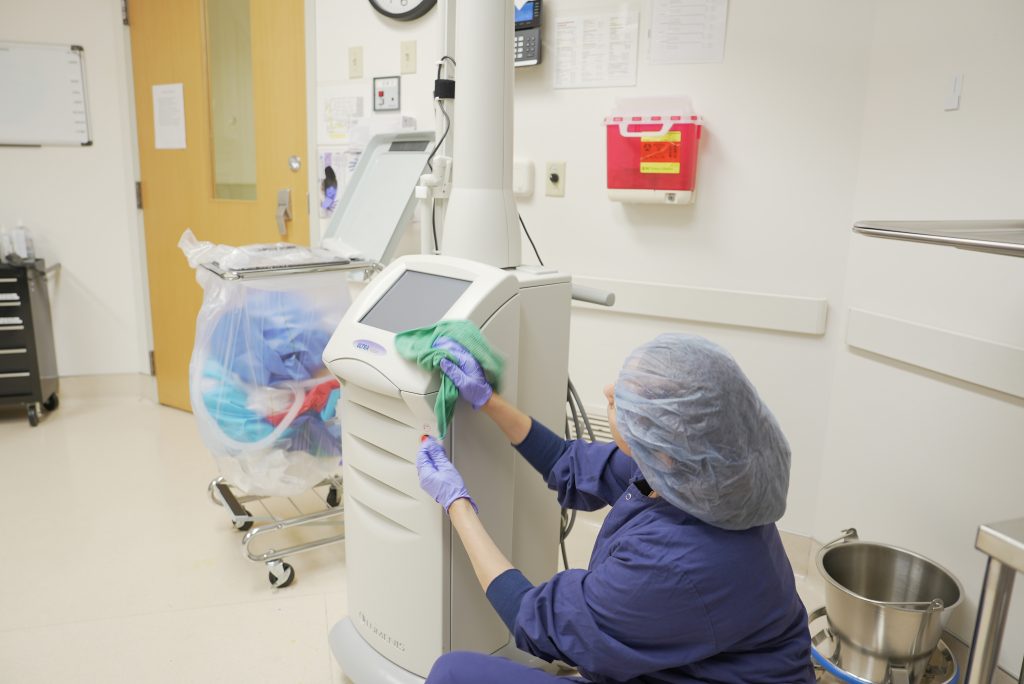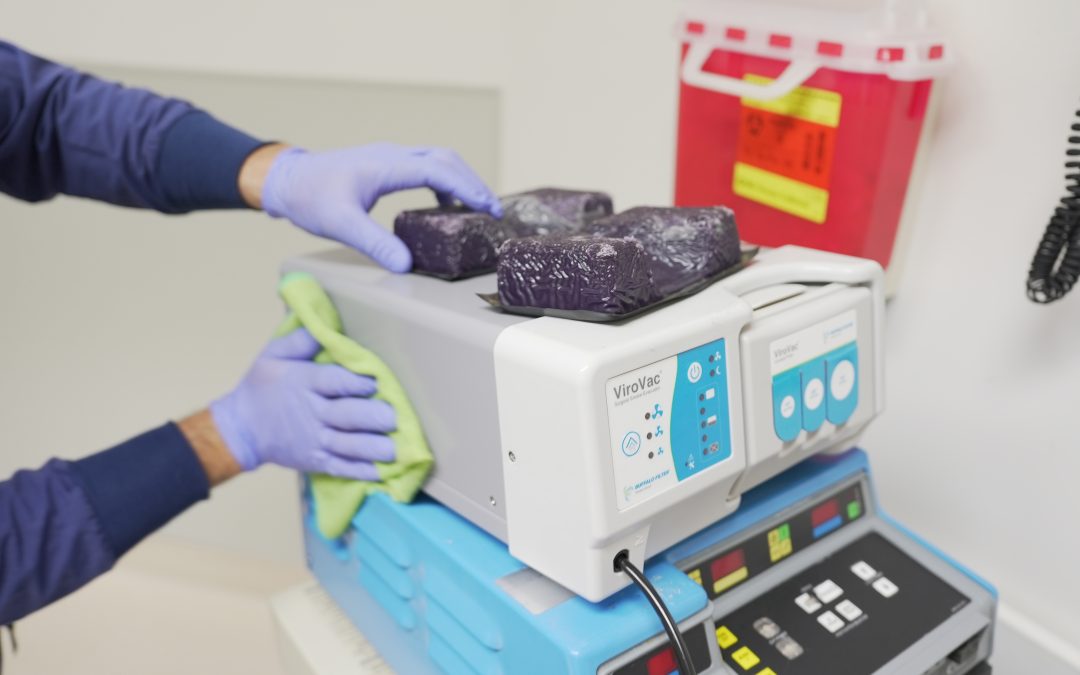Setting the Standard for Safety, Compliance, and Care
When it comes to maintaining safe, sanitary environments in healthcare and other high-risk facilities, routine cleaning is not enough. Terminal cleaning is a specialized, thorough process designed to eliminate pathogens and reduce the risk of infection. Unlike daily cleaning or turnover cleaning, terminal cleaning goes deeper, targeting every surface, fixture, and corner to ensure the highest standard of cleanliness.
At Cleanstart, we understand how essential this service is for protecting patients, staff, and visitors. With decades of expertise, trained and certified technicians, and advanced cleaning technology, we bring proven methods and peace of mind to every project. Cleanstart holds the Certified Surgical Cleaning Technician (CSCT) credential through the Association for the Healthcare Environment (AHE) and is also qualified to provide CSCT training.
Why Terminal Cleaning Matters
Infection prevention is one of the most significant challenges healthcare facilities face. Terminal cleaning is not just about appearances; it’s about safety, compliance, and building trust.
- Infection Control: Properly performed terminal cleaning reduces the risk of healthcare-associated infections (HAIs), protecting vulnerable patients and staff.
- Cross-Contamination Prevention: Without strict cleaning protocols, pathogens can easily be transferred from one patient room, workstation, or piece of equipment to another. Terminal cleaning breaks this cycle by using hospital-grade disinfectants, microfiber systems, and color-coded tools to stop contaminants from spreading throughout your facility.
- Safety Compliance: Every step of the process is designed to meet OSHA, CDC, and Joint Commission requirements, ensuring your facility remains compliant.
- Public Confidence: Families, patients, and healthcare professionals feel safer and more at ease in a facility that is visibly clean and consistently maintained.
While hospitals and clinics are the most common environments, labs, cleanrooms, dental offices, and food-processing facilities also depend on terminal cleaning to uphold critical hygiene standards. Cleanstart is here to ensure your facility isn’t just clean, but also safe, sanitary, and compliant at every level.

Critical Components of Terminal Cleaning
Cleanstart’s process is thorough and methodical, addressing every area that could harbor bacteria, viruses, or contaminants. By targeting both obvious and often-overlooked spaces, we ensure a complete clean that meets healthcare and safety standards, providing you with peace of mind and reassurance.
- High-Touch Surfaces: Areas frequently touched by patients, staff, and visitors, such as bed rails, door handles, light switches, and handrails, are disinfected with hospital-grade products. These surfaces are the most common points of transmission and demand extra attention.
- Floors, Walls, and Ceilings: Dirt, dust, and pathogens can accumulate on all surfaces, not just the ones within immediate reach. Our team scrubs, mops, and disinfects floors while also cleaning walls and ceilings to eliminate biofilm and reduce airborne particles that settle over time.
- Restrooms and Sinks: Bathrooms and sink areas are hotspots for germs. We perform a deep clean of toilets, sinks, faucets, showers, and surrounding surfaces. Fixtures and handles are carefully disinfected to prevent cross-contamination in high-use areas.
- Medical Equipment and Fixtures: Patient care equipment, including beds, IV poles, monitors, wheelchairs, and other fixtures, is carefully cleaned and disinfected according to manufacturer guidelines and infection control protocols. This prevents pathogens from lingering on critical equipment.
- Air Vents and High Areas: Dust and pathogens can travel through HVAC systems and accumulate in elevated areas. Cleanstart performs high-dusting of vents, light fixtures, and overhead surfaces to reduce airborne contaminants and improve overall air quality.
By addressing these key components, Cleanstart ensures that no area is left untreated, creating a safe, sanitary environment that staff and patients can trust.
Terminal Cleaning Tools, Products, and Technology
Cleanstart uses the latest tools, products, and protective measures to ensure that every terminal cleaning project is performed safely and effectively. Our combination of advanced equipment and certified techniques allows us to deliver consistent, verifiable results while preventing cross-contamination between spaces.
- Personal Protective Gear (PPG): Every technician is equipped with gloves, gowns, masks, face shields, and shoe covers. Proper donning and doffing procedures are strictly followed to protect both staff and patients while reducing the risk of cross-contamination.
- Hospital-Grade Disinfectants: EPA-registered disinfectants proven effective against MRSA, C. diff, COVID-19, and more are carefully applied to eliminate dangerous pathogens without damaging surfaces.
- Electrostatic Sprayers & Foggers: These tools provide even disinfectant coverage, ensuring that all surfaces, including irregular shapes and hard-to-reach areas, are fully treated. This helps eliminate potential hotspots for pathogen transfer.
- Microfiber Cleaning Systems: Microfiber traps dirt and bacteria at the microscopic level, unlike cotton rags or paper products. Cleanstart uses color-coded microfiber systems specifically to avoid cross-use between patient rooms and facility areas.
- HEPA Filtration Vacuums: These vacuums capture particles as small as 0.3 microns, preventing contaminants from being redistributed into the air and spreading to adjacent areas.
By combining protective gear with cutting-edge cleaning technology, Cleanstart ensures that terminal cleaning is performed with maximum safety, precision, and effectiveness.

Cleanstart’s Terminal Cleaning Process:
Cleanstart technicians follow strict, standardized protocols to ensure every cleaning project meets terminal healthcare-level requirements. Each step is designed to minimize risks, eliminate pathogens, and provide verifiable results.
- Preparation & Containment: Before cleaning begins, the area is secured. Signage and barriers are placed to restrict access, and technicians don the appropriate personal protective gear (PPG) such as gowns, gloves, masks, and face shields. Containment measures, including closing doors and sealing vents if necessary, are set up to prevent cross-contamination to surrounding areas.
- Removal of Waste & Linens: All trash, biohazards, and soiled linens are safely removed from the space. Items are bagged and disposed of in compliance with OSHA and healthcare waste protocols. This step ensures that contaminated materials are not spread to other parts of the facility.
- Thorough Cleaning: Using microfiber systems and HEPA vacuums, technicians remove dirt, dust, and biofilm from every surface. Not just visible areas, but also behind furniture, under equipment, and in hard-to-reach corners. Cleaning is performed from high surfaces down to the floor to prevent recontamination.
- Disinfection & Sanitization: Once surfaces are cleaned, EPA-registered hospital-grade disinfectants are applied. Electrostatic sprayers and foggers may be used to ensure even coverage on flat and irregular surfaces. Special attention is given to high-touch points, such as bed rails, light switches, door handles, and medical equipment, where pathogens are most likely to spread.
- Inspection & Verification: After cleaning and disinfection, supervisors conduct a detailed visual inspection. In high-risk settings, ATP (adenosine triphosphate) testing may be used to confirm that biological matter has been removed to acceptable standards. This verification step ensures consistency and accountability.
- Final Sign-Off: Once inspection and testing are complete, the space is cleared for use. A supervisor documents the completion, ensuring that proper records are maintained for compliance audits. Only then is the room or facility reopened, providing peace of mind that it is safe, sanitary, and compliant.
Why Choose Cleanstart
With more than 25 years of professional cleaning experience, Cleanstart has the expertise to meet the most demanding cleaning standards. Every member of our cleaning team is trained and certified in terminal cleaning protocols, so you can be confident that strict requirements are met on every project.
- Reduced infection risks for patients and staff.
- Compliance with healthcare standards and inspections.
- Healthier, safer environments for everyone who enters your facility.
- Reliable scheduling and flexibility to minimize disruption.
- Certified Surgical Cleaning Technician (CSCT)

Frequently Asked Questions About Terminal Cleaning
What is the difference between terminal cleaning and deep cleaning?
Deep cleaning targets built-up dirt and grime, while terminal cleaning focuses on eliminating pathogens in healthcare and high-risk environments.
How often should terminal cleaning be performed?
It depends on the facility, but it’s typically required after patient discharge, isolation cases, or at scheduled intervals in high-risk areas.
Is terminal cleaning only for hospitals?
No. Labs, cleanrooms, dental clinics, and food-processing facilities also require terminal cleaning.
What disinfectants do you use?
We use EPA-registered hospital-grade disinfectants proven effective against dangerous pathogens, while choosing eco-conscious products whenever possible.
How does Cleanstart ensure quality control?
Through strict protocols, supervisor inspections, and, in some cases, ATP testing to verify results.
Does terminal cleaning help prevent cross-contamination?
Yes. Cleanstart uses strict cleaning protocols, including color-coded microfiber systems, sealed waste disposal, and proper PPE use, to stop pathogens from spreading between rooms and facility areas.
Who performs terminal cleaning at Cleanstart?
Every member of our cleaning team is trained and certified in terminal cleaning protocols, ensuring strict compliance and professional standards are met on every project.
Can terminal cleaning be scheduled after hours?
Absolutely. Cleanstart offers flexible scheduling, including nights and weekends, to minimize disruption to your operations and patient care.
What areas are included in a terminal cleaning service?
Terminal cleaning covers every surface in the room or facility, including walls, floors, ceilings, vents, high-touch points, medical equipment, and restroom fixtures.
How is terminal cleaning different from turnover cleaning?
Turnover cleaning is a quicker, routine process between patient visits. Terminal cleaning is a top-to-bottom, end-of-use cleaning that eliminates pathogens and ensures compliance with healthcare standards.
Certified Terminal Cleaning Services You Can Trust
Terminal cleaning is crucial for maintaining health, ensuring compliance, and fostering confidence in your facility. Trust Cleanstart to deliver the highest level of care and precision every time. Contact us today at (253) 921-2593 or complete our online form to schedule professional terminal cleaning services.







